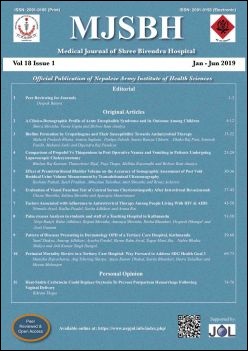Perinatal Mortality Review in a Tertiary Care Hospital: Way Forward to Address SDG Health Goal 3
Keywords:
Perinatal mortality, SDG3 Nepal, Perinatal Audit, PSANZ classificationAbstract
Introduction: Sustainable development goal 3 targets at ensuring healthy lives and promoting well-being for all at all ages. One of the component for achievement of this goal is improvement of maternal and child health; the indicators of which is perinatal mortality rate. The aim of this study was to evaluate the cause of perinatal death in a tertiary care medical centre, which may help to reduce the incidence of perinatal death and improve the quality of care.
Methods: A prospective study was done over a period of one year from April 2016 to March 2017. Causes of perinatal deaths based on PSANZ classification were recorded along with patients demographics and also avoidable factors were evaluated.
Results: Out of total 1275 deliveries, there were 21 perinatal deaths including three intrauterine foetal deaths, one still birth and seven early neonatal deaths. The perinatal mortality rate was 16.27 per 1000 birth. Majority of perinatal deaths (19%) occurred due to congenital anomalies followed by (14%) hypertensive disorder in pregnancy, intrapartum hypoxia (14%), unexplained causes (14%), 9.5% cord prolapse, antepartum haemorrhage (9.5%), 5% due to intrauterine growth restriction, gestational diabetes mellitus or preterm labour. Most of the mothers whose baby had perinatal deaths had ANC outside. Most of the deaths occurred in between gestational age of 37 to 41 weeks. Perinatal mortality was more in multigravida. Delay to seek health care and inadequate antenatal checkups were the most common avoidable factors.
Conclusions: Congenital anomalies and hypertensive disorders during pregnancy were the most common causes of perinatal death. Delay in health seeking behaviour was the most common avoidable factors for perinatal death. We recommend early identification of high risk pregnancy through proper antenatal screening, educating pregnant women to identify danger signs of pregnancy, creating public awareness about importance of antenatal checkups, vigilant labour monitoring for foetal distress, to reduce some categories of deaths.
Downloads
Downloads
Published
How to Cite
Issue
Section
License
This license enables reusers to distribute, remix, adapt, and build upon the material in any medium or format for noncommercial purposes only, and only so long as attribution is given to the creator.




